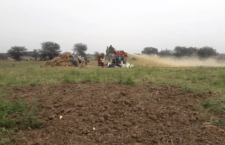Tuberculosis, pneumonia, and malnutrition are ailments that continue to plague rural communities, regardless of the hard-fought battle against the pandemic. Khabar Lahariya shines a light on how the rural healthcare system in Bundelkhand is holding up beyond Covid-19
India, which has the world’s largest vaccine manufacturer, has now rolled out the world’s largest inoculation program too. But as phase-wise vaccination begins with the healthcare workers and senior citizens, healthcare beyond Covid continues to receive little to no attention.
In Bundelkhand, Covid vaccination camps have been set up across towns. In Atarra, part of Banda District, healthcare worker Madhuri Gupta has received a robust 3-day training regarding what she needs to ask the healthcare workers before the vaccine is administered to them. “People with chronic diseases, allergies or who have recently recovered from illnesses like flu as well as pregnant women and lactating mothers and people younger than eighteen years old are not supposed to receive the vaccine.”, Madhuri elaborates. Not so far away in village Laxmanpur in Lalitpur district, lactating mothers and infants face the opposite problem. There is no one to educate them about crucial life-saving vaccines and help them make informed decisions. They have been requesting for an Aanganwadi for years but no one seems to have noticed. The result is malnutrition amongst pregnant women and children, illiteracy and lack of access to government programmes that could have helped improve their condition.
India spends a little over 1% of its GDP on its healthcare for a population of approximately 1.4 billion people. In 2020, the already burdened system was stretched beyond its limits when it had to handle a pandemic without any preparation or sustained government support. The vaccination drive is definitely a step in the right direction for the health workers who have continued to care for patients with limited resources. But in the background a silent network of diseases has continued to strike, which the existing infrastructure has no means of fighting. Tuberculosis is one such deadly disease that has left families devastated in Bundelkhand. “We have so many people in our village who are suffering from other diseases like tuberculosis”, says Kamta Prasad of Mawai Kala village in Banda District, ‘The government is not doing anything about that. It’s only busy with Corona.” Kailash has been suffering from TB and Jaundice but there is no one to guide him or help him figure out why the government hospital-issued medicines are no longer effective for him. His wife and small child are dependent on him but he is in no condition to work and support his family. Another resident, Attho, has been suffering from TB for the past four years. During the lockdown, he had to pay 2400 rupees just to go to the government hospital in nearby Naya Gaon to get his medicine. “People go to the local medical center but they are not able to service them here. They end up going to Chhaoni, Allahabad, and other towns to get their treatment.” Says Rajoi Kumar.
The private health sector has reaped big benefits from the stimulus package announced by the government. Private hospitals that make for two-thirds of the hospital beds in India serviced less than ten percent of the critical Covid patients. Now, as the government focuses solely on the vaccine roll-out, the ailing citizens have turned to the private sector once again and it comes at a high price. Exorbitant treatment for diseases like TB which are supposed to be treated for free with the DOTS programme have led many families in Bundelkhand to abject poverty and in a certain case, suicide. Rendered weak, unable to work or care for himself, a young man from Achreel village in Banda, who was suffering from TB for four years took his own life.
Rural healthcare in India gets away with doing the bare minimum, and in some cases perform such gross malpractices that villagers choose to take on heavy debt to pay for private medical treatment. One such disease that it is supposed to effectively battle is Pneumonia which still continues to be a life-threatening condition in villages of Bundelkhand. No proper doctors, facilities or access to medicine is the norm despite a seemingly robust ASHA programme in place to tackle detection and prevention of tuberculosis. In Kandeha, a village in Chitrakoot district, many residents seem to fall prey to it frequently and yet no government help seems to be in sight.
This is not a post-Covid occurrence. Many village residents aged and young suffer from it almost through the year. You won’t find many families that haven’t spent a small fortune on medicines from the ‘store’ or consultation with private clinics nearby. While pneumonia is a leading killer of children under five, grabbing a 17% share of Infant Mortality Rate, more than half of them do not receive any medical care.
“I feel a lot of happiness that the government has found a fast and effective solution to the pandemic and have deployed it to the doctors and medical staff first”, says Naina Sachan, a healthcare worker from District Hospital Banda. Across the board doctors and healthcare workers are giving their vote of confidence to the new vaccine and the roll-out seems to be progressing in a structured manner. Yet, the complete breakdown of this same healthcare system for diseases that are preventable and that have ravaged villages after villages continue to exist without a proper plan from the government.
Vinod Kumar, CMO, Chitrakoot, is convinced that the new Coronavirus vaccine is safe and efficacious and will help us overcome the pandemic and bring back some semblance of life before covid. For pregnant mothers in Lalitpur and TB patients in Mawai Kala, this vote of confidence means little, as the state of rural healthcare beyond Covid-19 still has a long way to go to truly serve the communities it’s meant to.

